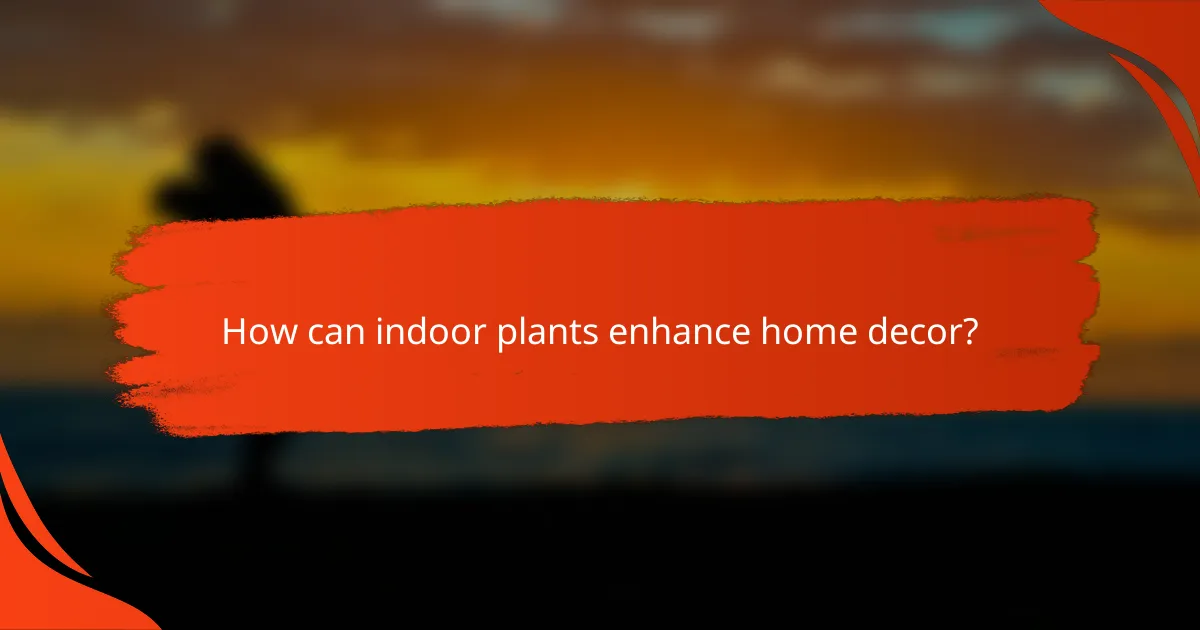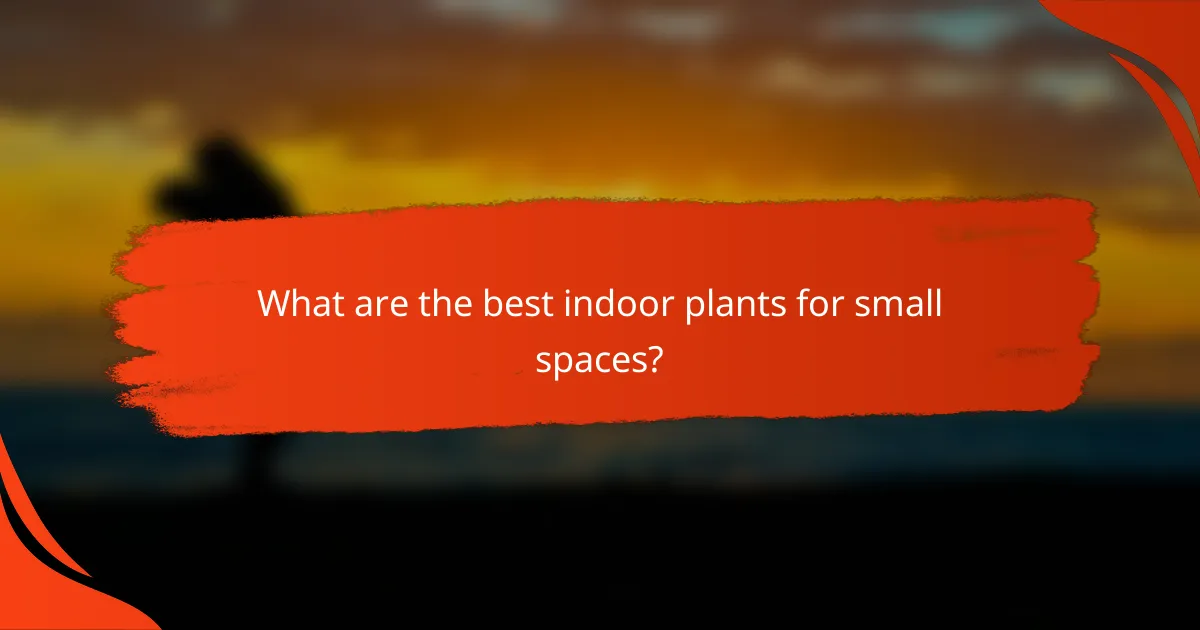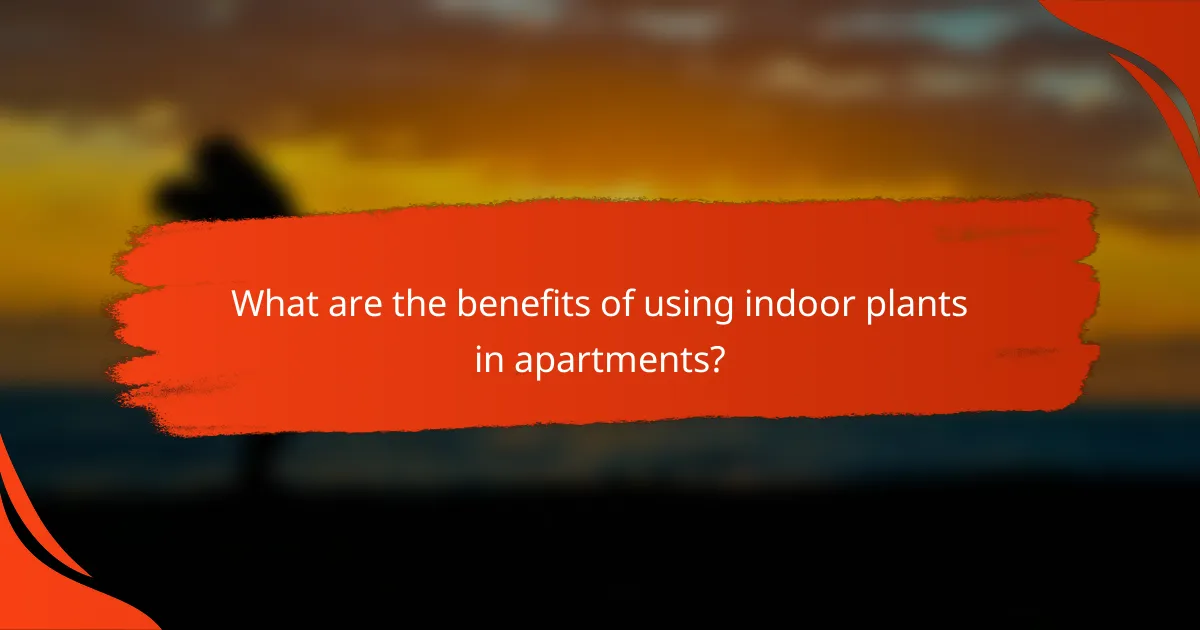Indoor plants are a fantastic way to elevate your home decor, bringing natural beauty and improved air quality into your living space. By selecting the right plants and arranging them thoughtfully, you can create a vibrant atmosphere that enhances your aesthetic while efficiently utilizing available space.

How can indoor plants enhance home decor?
Indoor plants significantly enhance home decor by adding natural beauty, improving air quality, and allowing for personalized aesthetic styles. They serve as vibrant focal points that can transform any space into a more inviting and lively environment.
Visual appeal through greenery
Incorporating indoor plants into your decor creates a refreshing visual contrast against walls and furniture. Greenery can soften harsh lines and add texture, making spaces feel more dynamic and alive.
Consider using plants of varying heights and leaf shapes to create depth. For example, tall floor plants like fiddle leaf figs can complement shorter table plants like succulents, creating an engaging visual hierarchy.
Improved air quality
Indoor plants contribute to better air quality by filtering toxins and releasing oxygen. Common houseplants such as snake plants and peace lilies are known for their air-purifying properties, making them excellent choices for improving indoor environments.
To maximize air quality benefits, group several plants together. This can enhance their collective impact, as they work synergistically to cleanse the air in your home.
Personalized aesthetic styles
Indoor plants allow homeowners to express their personal style through various design themes. Whether you prefer a minimalist look with a single succulent or a lush jungle vibe with multiple varieties, plants can be tailored to fit any aesthetic.
Choose pots and planters that align with your decor style. For instance, sleek ceramic pots work well in modern settings, while rustic wooden planters suit farmhouse themes. This attention to detail can elevate your overall decor significantly.

What are the best indoor plants for small spaces?
The best indoor plants for small spaces are those that require minimal care while maximizing aesthetic appeal. Options like succulents, snake plants, and pothos thrive in limited areas and can enhance your decor without overwhelming the environment.
Succulents for low maintenance
Succulents are ideal for small spaces due to their compact size and low maintenance needs. They require minimal watering, making them perfect for busy individuals or those new to plant care.
Common varieties include jade plants and haworthias, which can thrive in small pots on windowsills or shelves. Ensure they receive adequate sunlight, ideally around six hours a day, to maintain their vibrant colors and health.
Snake plants for vertical growth
Snake plants are excellent for vertical growth, making them suitable for tight spaces. Their upright leaves can reach heights of about two to four feet, allowing them to fit into corners or narrow areas without taking up much floor space.
These plants are also known for their air-purifying qualities, which can improve indoor air quality. They thrive in indirect light and require infrequent watering, making them a hassle-free choice for busy households.
Pothos for trailing vines
Pothos plants are perfect for adding a touch of greenery with their trailing vines, which can grow several feet long. They can be placed on shelves or in hanging baskets, allowing them to cascade beautifully and utilize vertical space effectively.
This plant is adaptable to various lighting conditions, from low light to bright indirect light, and requires watering only when the soil is dry. Their resilience makes them a great option for beginners or those with less-than-ideal growing conditions.

How to arrange indoor plants for maximum impact?
To arrange indoor plants for maximum impact, consider their placement, height, and visual appeal. A well-thought-out arrangement enhances aesthetics and utilizes space effectively, creating a vibrant atmosphere.
Layering plants for depth
Layering plants involves placing taller plants at the back and shorter ones in front to create a sense of depth. This technique draws the eye and adds dimension to your space. Consider using a mix of foliage types, such as broad-leaved plants behind delicate ferns, to enhance visual interest.
When layering, aim for a variety of textures and colors. For example, pairing a tall snake plant with a cascading pothos can create a striking contrast. Ensure that all plants receive adequate light by positioning them according to their needs.
Using plant stands for height variation
Plant stands are an excellent way to introduce height variation in your indoor plant arrangement. By elevating certain plants, you can create visual layers that make the space feel more dynamic. Choose stands that complement your decor style, whether modern or rustic.
Consider using stands of different heights to create a staggered effect. A common approach is to place taller plants on higher stands and shorter ones on the floor or lower shelves. This not only enhances aesthetics but also ensures that each plant gets sufficient light.
Grouping plants by size and color
Grouping plants by size and color can create a cohesive look that enhances your decor. For instance, cluster small, vibrant plants together to form a lively display, or group larger plants to create a focal point. This method allows for easy maintenance and watering.
When grouping, consider the color palette of your plants. Combining various shades of green with pops of color from flowering plants can create a vibrant arrangement. Aim for odd numbers in groupings, such as three or five, for a more natural appearance.

What are the benefits of using indoor plants in apartments?
Indoor plants offer numerous benefits for apartment living, including improved air quality, enhanced aesthetics, and increased emotional well-being. By incorporating greenery, residents can create a more inviting and healthier living environment.
Space utilization through vertical gardens
Vertical gardens are an effective way to maximize space in apartments, especially in smaller areas. By utilizing wall space, you can create a lush display of plants without sacrificing floor area. Consider using wall-mounted planters or trellises to showcase a variety of plants.
When designing a vertical garden, choose plants that thrive in your specific light conditions. Herbs, ferns, and succulents are popular choices that can flourish in limited spaces. Ensure proper watering and drainage to maintain plant health.
Noise reduction with plant placement
Strategically placing indoor plants can help reduce noise levels in apartments. Plants absorb sound and can act as natural sound barriers, making your living space quieter and more serene. Larger plants, such as rubber trees or fiddle leaf figs, are particularly effective at dampening noise.
To optimize noise reduction, position plants near windows or walls that face busy streets. Grouping plants together can enhance their sound-absorbing capabilities, creating a more peaceful atmosphere in your home.
Creating a calming environment
Indoor plants contribute to a calming environment by promoting relaxation and reducing stress. The presence of greenery can lower anxiety levels and improve mood, making your apartment a more tranquil space. Consider incorporating plants like peace lilies or snake plants, which are known for their soothing qualities.
To enhance the calming effect, arrange plants in areas where you spend the most time, such as living rooms or bedrooms. Use soft lighting and natural materials to complement the greenery, creating a harmonious and inviting ambiance.

How to choose the right pots and planters?
Choosing the right pots and planters is essential for the health of your indoor plants and the overall aesthetic of your space. Consider factors such as material, size, and design to ensure your plants thrive and complement your decor.
Material selection for durability
When selecting pots and planters, prioritize materials that offer durability and support plant health. Common options include ceramic, plastic, and terracotta, each with unique benefits. For instance, ceramic pots are sturdy and retain moisture well, while plastic pots are lightweight and often more affordable.
Consider the climate of your indoor space as well. If you have high humidity, choose materials that resist mold, like glazed ceramics. For dry environments, breathable materials like terracotta can help prevent overwatering.
Size considerations for plant growth
Size is a critical factor in choosing pots and planters, as it directly impacts plant growth. Ensure that the pot is large enough to accommodate the root system of your plant, allowing for healthy development. A general rule is to select a pot that is 1-2 inches larger in diameter than the current root ball.
Be cautious with oversized pots, as they can retain excess moisture, leading to root rot. For smaller plants, consider using pots that are proportional to their size to maintain balance and aesthetics in your space.
Design compatibility with decor
The design of your pots and planters should harmonize with your overall decor style. Consider colors, shapes, and textures that complement your existing furnishings. For a modern look, sleek, minimalist pots in neutral tones work well, while vibrant, patterned pots can add a playful touch to eclectic spaces.
Additionally, think about the placement of your plants. Hanging planters can save floor space and create visual interest, while floor-standing pots can serve as statement pieces. Always aim for a cohesive look that enhances your indoor environment.


